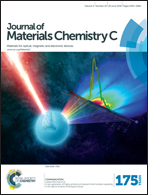Power-efficient solution-processed red organic light-emitting diodes based on an exciplex host and a novel phosphorescent iridium complex†
Abstract
High power-efficiency solution-processed red phosphorescent organic light-emitting diodes (s-PhOLEDs) are urgently needed in OLED displays and lighting applications. Herein, we have synthesized a novel solution-processable red heteroleptic iridium complex bis[2-di(p-methoxyphenyl) amino (9,9-diethylfluoren-2-yl)-5-(trifluoromethyl) pyridine][acetylacetonate] iridium(III), i.e. Ir(DPA-Flpy-CF3)2acac, which shows efficient red photoluminescence with an emission peak located at 602 nm. This novel red phosphor possesses a high absorption coefficient in the long wavelength region, ensuring the efficient energy transfer from the interfacial exciplex host to the phosphor guest at low phosphor-doping concentration. The optimized red s-PhOLED based on the red Ir(DPA-Flpy-CF3)2acac shows a maximum external quantum efficiency of 19.3% and a power efficiency of 44.5 lm W−1 with Commission International de L'Eclairage (CIE) coordinates of (0.64, 0.36). It is so far the highest power efficiency ever reported for red s-PhOLEDs and is comparable to state-of-the-art red PhOLEDs prepared by thermal evaporation.


 Please wait while we load your content...
Please wait while we load your content...